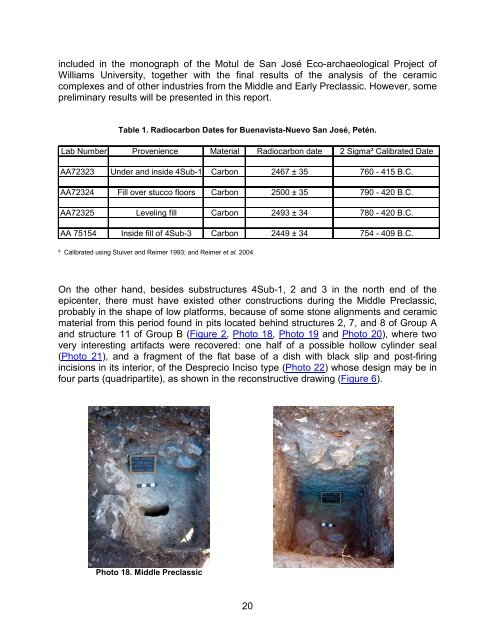Buenavista-Nuevo San José, Petén, Guatemala: Another ... - Famsi
Buenavista-Nuevo San José, Petén, Guatemala: Another ... - Famsi
Buenavista-Nuevo San José, Petén, Guatemala: Another ... - Famsi
Create successful ePaper yourself
Turn your PDF publications into a flip-book with our unique Google optimized e-Paper software.
included in the monograph of the Motul de <strong>San</strong> <strong>José</strong> Eco-archaeological Project of<br />
Williams University, together with the final results of the analysis of the ceramic<br />
complexes and of other industries from the Middle and Early Preclassic. However, some<br />
preliminary results will be presented in this report.<br />
Table 1. Radiocarbon Dates for <strong>Buenavista</strong>-<strong>Nuevo</strong> <strong>San</strong> <strong>José</strong>, <strong>Petén</strong>.<br />
Lab Number Provenience Material Radiocarbon date 2 Sigma² Calibrated Date<br />
AA72323 Under and inside 4Sub-1 Carbon 2467 ± 35 760 - 415 B.C.<br />
AA72324 Fill over stucco floors Carbon 2500 ± 35 790 - 420 B.C.<br />
AA72325 Leveling fill Carbon 2493 ± 34 780 - 420 B.C.<br />
AA 75154 Inside fill of 4Sub-3 Carbon 2449 ± 34 754 - 409 B.C.<br />
² Calibrated using Stuiver and Reimer 1993; and Reimer et al. 2004.<br />
On the other hand, besides substructures 4Sub-1, 2 and 3 in the north end of the<br />
epicenter, there must have existed other constructions during the Middle Preclassic,<br />
probably in the shape of low platforms, because of some stone alignments and ceramic<br />
material from this period found in pits located behind structures 2, 7, and 8 of Group A<br />
and structure 11 of Group B (Figure 2, Photo 18, Photo 19 and Photo 20), where two<br />
very interesting artifacts were recovered: one half of a possible hollow cylinder seal<br />
(Photo 21), and a fragment of the flat base of a dish with black slip and post-firing<br />
incisions in its interior, of the Desprecio Inciso type (Photo 22) whose design may be in<br />
four parts (quadripartite), as shown in the reconstructive drawing (Figure 6).<br />
Photo 18. Middle Preclassic<br />
20
















